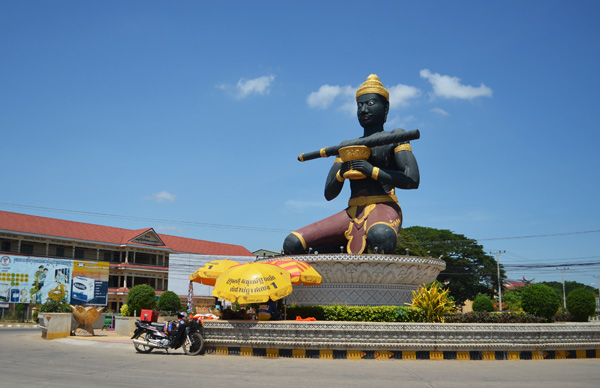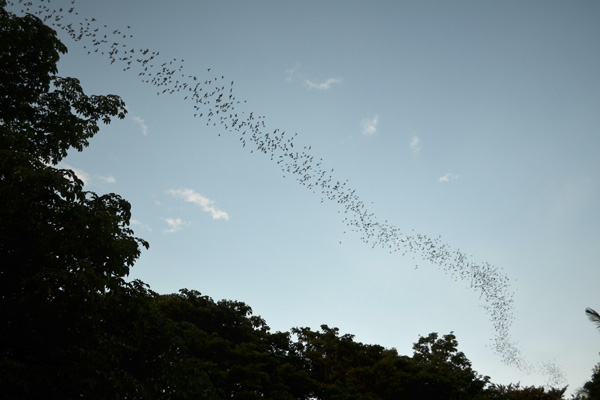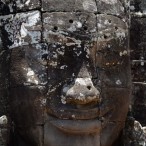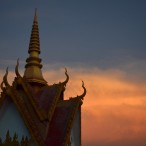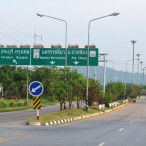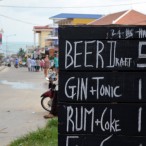Battambang, Cambodia’s second largest city after Phnom Penh is extremely laid back. While Phnom Penh reminded me of a mini version of Bangkok, Battambong rolled along at a much different and more relaxed pace. The streets were quieter, the buildings shorter and the air, while still extremely hot, was less polluted.
I decided to spend one full day seeing what sites I could in Battambang. As it was April, the temperatures were nearing 40 degrees celsius. I knew I wanted to see the Bamboo Railway and the Bat cave but didn’t realize how nicely things would work out. Our tuk tuk driver had our day mostly planned out for us and for a small fee of $10, whisked us off early in the morning.
Grandfather Battambang:
First, he took us by a few statues around the city and gave us some history of their pasts. One was of Grandfather Battambang, a farmer who lost his stick after throwing it at a runaway cow. It was rebuilt after the Vietnamese installed government destroyed the original. People were bringing offerings as we observed.
Bamboo Railway:
Next stop was the Bamboo train about 10-15 minutes outside town. In the past the train was used to transport goods but a certain novelty has made it popular for tourists. When another cart is coming from the opposite direction, your “bamboo car” is quickly dismantled and taken off the track to make way, only to be reassembled after the train has passed. Unfortunately, I got the impression that most of the $5 I was charged went straight to the boss man (police) standing watch.
Phnom Sampeu:
After an afternoon break from the heat (recommended), we commenced our trip and headed for Phnom Sampeu, a mountain that strangely sticks out of the flat, rice paddy covered landscape. It takes a good 20-30 minutes but is well worth the trip. Upon our arrival, bats by the millions began flying out of a cave in the mountain’s side. And they didn’t stop. Millions kept pouring out. Pretty ridiculous. Once we had had our fill of bats, we decided to head up the mountain. Phnom Sampeu is another location used by the Khmer Rouge in their oppressive regime. A few killing caves were used as mass graves and now bear memorials to those who met their end there. The mountain is also the resting place of a World War II relic. A large German machine gun used by the Japanese. Finally we hiked the rest of the way to the top of the hill where a few wats now sit. If you time it right, you can catch the bats and then the sunset from the top. A day well spent.
Our tuk tuk driver ended up being a great help. Not only did he provide as much history as he could, he even walked with us up the mountain so we wouldn’t get lost (There are multiple ways up. It’s not as as straightforward as it looks). He really cared for his country and shared how he had worked with the new government to reconnect with villages whose relations were poor after years of war. One thing he didn’t understand was where all the tourist fees being collected went. No improvements that he could see. Unfortunately, Cambodian police aren’t corruption free.
Where to Stay:
Upon the buses arrival, anyone resembling a tourist was swamped by eager tuk tuk drivers holding up laminated hotel advertisements. A buddy of mine had referred me to Chayya Hotel so I found a man waving one of their fliers and was quickly escorted to his mode of transportation, much to the disappointment of his competition. The ride was free with a room. A private room with A/C was $10, but there were also non A/C privates for $5 and dorm bes for $3. Another popular spot which is just around the corner is the Royal Hotel with comparable rates.
Eating/Drinking:
There is a large market just down the street from Chayya provided the cheapest option, but both of my meals there were quite disappointing. Restaurants dot the surrounding area and usually run from $3-$5 a plate. The restaurant directly outfront of Chayya and to the right was quite satisfying. Lok Lak is always a good choice when in Cambodia. Nightlife was scarce in comparison to Phnom Penh and Siem Reap and Anchor drafts were surprisingly hard to come by.
Getting There:
My $6 bus journey from Siem Reap to Battambang took only 3 hours seemed quite quick, but that may have been due to the fact that I was asleep for all of it. I also had the option of taking the boat across the Tonle Sap. But at almost three times the price ($24) and and three times the length, I decided to pass. My roommate actually did it and found it pretty entertaining, but also a very long day. There are also daily services to Phnom Penh that take the better part of the day.

